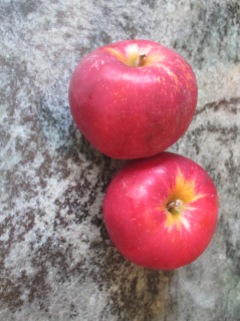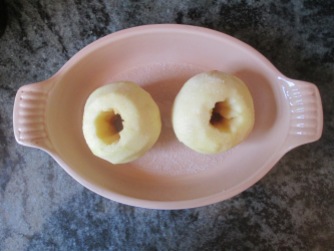Last weekend I had the pleasure of participating in a workshop about apples and preservation. Matt Kaminsky spoke about wild apples and grafting as a practice for preserving and propagating varieties. In addition to sharing a number of apple recipes from this site, my contribution to the workshop was to reflect on how updating recipes is a form of preservation of knowledge and to share this seventeenth-century recipe “to Candy pippins to look like amber” from UPenn Ms. Codex 252 (120r).
to Candy pippins to look like amber
take faire large pipins and pare them and bore a hole
through them and put them in an earthen platter in
the ouen stroueing fine sifted sugar upon them, then
sprinkell A littill rose water upon the suger then
bak them in an ouen lett your ouen be hot as for manhant
you stoppe up the ouen and lett them remane in halfe
an houer then tak them out of the dish and lay
them on a lettis or siue an so lett them remaine dry
2 or 3 dayes then thay will Looke clear as Amber
and be finely candied you may keep them all
the yeare
Designed with preservation and storage in mind, this recipe uses sugar, rosewater, and heat to transform the tender flesh of apples in season. The instructions ask you to cook your peeled apples in a hot bread oven “as hot as for manhant” or manchet bread. Then they dry for 2 or 3 additional days before storage.
Before the workshop, I’d been exploring this recipe with the juicy Arlet apple (a personal favorite). I even tested it as a sliced apple recipe – considering the various meanings of “pare” – but decided in the end that the recipe called for whole, cooked apples. (Sidenote: Season some apple chips with rosewater and sugar this fall for a delicious treat.) At the workshop, Matt suggested using a spongier, less juicy apple variety for this preparation. After consulting with the vendors from Three Springs Fruit Farm at my local market, I decided to try the recipe one more time with Jonathan apples.
Updated Recipe
2 apples
1½ teaspoons sugar
1 teaspoon rosewater
Preheat your oven to 350F.
Peel and core the apples.
Place the apple on a baking sheet. Sprinkle sugar over apples. Then sprinkle rosewater over the apples.
Bake for 1 hour. Allow to cool completely on a cooling rack.
The Results
These apples fall somewhere between a baked apple and a dried, sugared apple. After baking, and especially after sitting out for a few days post-baking, the apples are a rich, golden color.
I ate one apple hot from the oven. It was gorgeously sweet and fragrant from rosewater. After two days sitting out, it was drier, denser, and more deeply flavored. The rosewater scent had dispersed, but it was even tastier.
If I were to test the recipe again, I might bake it longer or at a hotter temperature to see how much moisture I could draw out before resting. I might also add more sugar and rosewater to see how much “amber” effect I could create on the outside of the fruit. If you make any changes to the recipe as you try it out, let me know how it goes!










I think your oven temperature may be too hot. Since manchet has a white crust instead of brown, the temperature should be closer to 220°F. Or at least based on Thomas Dawson’s 1594 manchet recipe from “The good Huswifes Handmaide for the Kitchin”. The cellulose in the apple breaks down at about 183°F. Apple have about 10% sugar. I assume that to achieve clarity, the sugar concentration has to increase significantly. Thus, it seems like low and slow is required for this recipe.
I think I’d go with moderately thick slices with a convection setting to increase the drying. If you can remove most of the water and oxidize the sugar, you should get more of an amber-like appearance.
I have pippin apples from my tree if you’d like to try again sometime with that variety–they’re a fairly hard, tart apple that keeps well for a long time even without the cooking.
Thank you for this kind offer, Laurel!
I’ve just tried this. The result was two heavily carbonised lumps and an interesting cleaning job (thank goodness for decent non-stick baking trays). I notice that the original recipe says cook for half an hour, but the modern one says an hour. If I’d realised that before cooking (my fault entirely!) I’d have checked them earlier. Oh well. Fortunately, I only tried with two apples and we have plenty more!
Oh no! I’m sorry to hear that the recipe turned out that way. I’m not sure what happened because I know a few other readers baked their apples for a whole hour with good results. Thank you for reading and for giving the recipe a try. I hope the next thing you make from the site will be tasty and less of a strain on your baking trays.